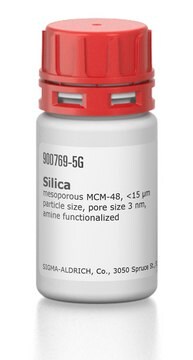938181
Silica
hollow nanoparticles, 1000 nm particle size, pore size 40 Å
Synonym(s):
Hollow silica, Hollow silica nanospheres, Hollow silicon dioxide, Silicon dioxide
About This Item
Recommended Products
Quality Level
form
powder
particle size
1000 nm
pore size
40 Å pore size
bp
2230 °C (lit.)
mp
>1600 °C (lit.)
SMILES string
O=[Si]=O
InChI
1S/O2Si/c1-3-2
InChI key
VYPSYNLAJGMNEJ-UHFFFAOYSA-N
Looking for similar products? Visit Product Comparison Guide
Related Categories
General description
Application
Storage Class
11 - Combustible Solids
wgk_germany
nwg
flash_point_f
Not applicable
flash_point_c
Not applicable
Choose from one of the most recent versions:
Certificates of Analysis (COA)
It looks like we've run into a problem, but you can still download Certificates of Analysis from our Documents section.
If you need assistance, please contact Customer Support.
Already Own This Product?
Find documentation for the products that you have recently purchased in the Document Library.
Our team of scientists has experience in all areas of research including Life Science, Material Science, Chemical Synthesis, Chromatography, Analytical and many others.
Contact Technical Service
